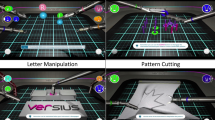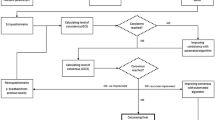Abstract
Virtual reality robotic simulation has gained widespread momentum. In order to determine the value of virtual reality robotic simulation and its objective metrics, a reality-based robotic surgical training platform with similar analytic capabilities must be developed and validated. The ProMIS laparoscopic surgical simulator is a widely available reality-based simulation platform that has been previously validated as an objective measure of laparoscopic task performance. In this study, we evaluated the validity of the ProMIS laparoscopic surgical simulator as an objective measure of robotic task performance. Volunteers were recruited from two experience groups (novice and expert). All subjects completed three tasks (peg transfer, precision cutting, intracorporeal suture/knot) in the ProMIS laparoscopic simulator using the da Vinci robotic surgical system. Motion analysis data was obtained by the ProMIS computerized optical tracking system and objective metrics recorded included time, path length, economy of motion, and observer-recorded penalty scores. The novice group consisted of 10 subjects with no previous robotic surgical experience. The expert group consisted of 10 subjects with robotic experience. The expert group outperformed the novice group in all three tasks. Subjects rated this training platform as easy to use, as an accurate measure of their robotic surgical proficiency, and as relevant to robotic surgery. The experts described the simulator platform as useful for training and agreed with incorporating it into a residency curriculum. This study demonstrates that the ProMIS laparoscopic simulator is a face, content, and construct valid reality-based simulation platform that can be used for objectively measuring robotic task performance.




Similar content being viewed by others
References
Pellen MGC, Horgan LF, Barton JR, Attwood SE (2009) Construct validity of the ProMIS laparoscopic simulator. Surg Endosc 23:130–139
VanSickle KR, McClusky DA, Gallagher AG, Smith CD (2005) Construct validation of the ProMIS simulator using a novel laparoscopic suturing task. Surg Endosc 19:1227–1231
Chandra V, Nehra D, Parent R, Woo R et al (2010) A comparison of laparoscopic robotic assisted suturing performance by experts and novices. Surgery 147(6):830–839
Narula VK, Watson WC, Davis SS, Hinshaw K, Needleman BJ, Mikami DJ, Hazey WH, Winston JH, Muscarella P, Rubin M, Patel V, Melvin WS (2007) A computerized analysis of robotic versus laparoscopic task performance. Surg Endosc 21:2258–2261
Derossis AM, Fried GM, Abrahamowicz M et al (1998) Development of a model for training and evaluation of laparoscopic skills. Am J Surg 175:482–487
Gallagher AG, Ritter EM, Satava RM (2003) Fundamental principles of validation, and reliability: rigorous science for the assessment of surgical education and training. Surg Endosc 17:1525–1529
Fried GM, Feldman LS, Vassiliou MC, Fraser SA, Stanbridge D, Ghitulescu G, Andrew CG (2004) Proving the value of simulation in laparoscopic surgery. Ann Surg 240:518–527
Undre S, Darzi A (2007) Laparoscopy simulators. J Endourol 21:244–247
Lendvay TS, Casale P, Sweet R, Peters C (2008) Initial validation of a virtual-reality robotic simulator. J Robotic Surg 2:145–149
Sethi AS, Peine WJ, Mohammadi Y, Sundaram CP (2009) Validation of a novel virtual reality robotic simulator. J Endourol 23(3):503–508
Conflict of interest
None.
Author information
Authors and Affiliations
Corresponding author
Rights and permissions
About this article
Cite this article
McDonough, P.S., Tausch, T.J., Peterson, A.C. et al. Initial validation of the ProMIS surgical simulator as an objective measure of robotic task performance. J Robotic Surg 5, 195–199 (2011). https://doi.org/10.1007/s11701-011-0256-9
Received:
Accepted:
Published:
Issue Date:
DOI: https://doi.org/10.1007/s11701-011-0256-9




